One sunny afternoon, I headed north from my hotel in La Condesa to explore a new neighbourhood in Mexico City. I hadn’t heard much about it. But I was entranced by these images of a Morrocan-inspired Gazebo and surrealist library. They were located in the hidden gem of a neighbourhood called Colonia Santa María la Ribera.
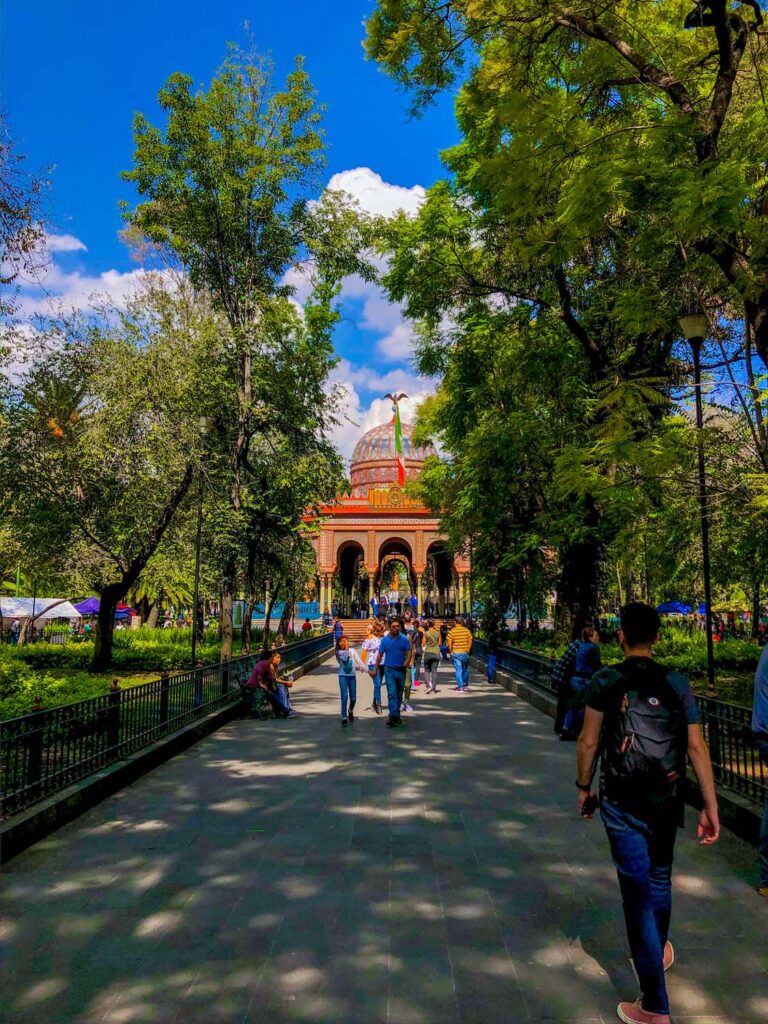
I was slightly hesitant to visit, to be honest. Although it was just northwest of the Historic Centre, it was also west of Lagunilla and Tepito. Lagunilla and Tepito are two of the so-called “barrio bravos,” the most dangerous neighbourhoods in Mexico City. When you’re visiting a new part of town, it’s always hard to tell how close things are to each other. And perhaps how much of those “bad neighbourhoods” bleed into the place you’re set to visit. I bravely set out in my Uber and travelled across the city. What I found was a place that seemed to beam with personality. A culinary and cultural gem! Truthfully, the neighbourhood has come a long way, and I never felt the least bit in danger. If anything, Colonia Santa María la Ribera was one of the friendliest parts of town I have yet to visit in CDMX.
People all over the central plaza were joyfully dancing in the heat of the afternoon sun. A charming 80-year-old man offered me a dance, but I was too shy to take part. But I very much regret not taking part. I had such a blast out in Colonia Santa María la Ribera. And I wanted to share with you all my favourite things to see and do in the Colonia Santa María la Ribera.
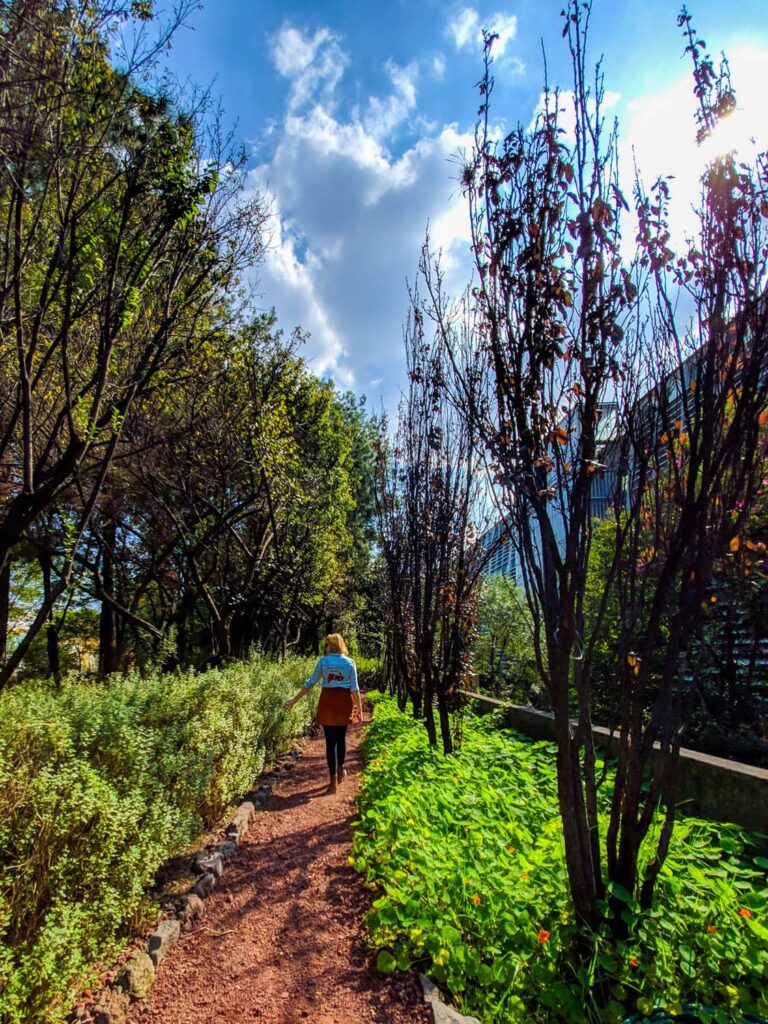
- History
- Location
- Map of Walking Tour
- Pasteleria El Globo
- Alameda de Santa María
- Kiosco Morisco
- Oaxacaquí
- Kolobok
- Tlacoyotitlán
- Corner of Jaime Torres Bodet and Calle Salvador Díaz Mirón
- Museo del Instituto de Geología
- Mercado La Dalia
- Tortillería y Molino La Dalia
- Restaurante La Oveja Negra
- Pulquería the Xochitl
- Santa María La Ribera Street
- Parroquia de la Sagrada Familia
- Museo Universitario del Chopo
- Biblioteca Vasconcelos
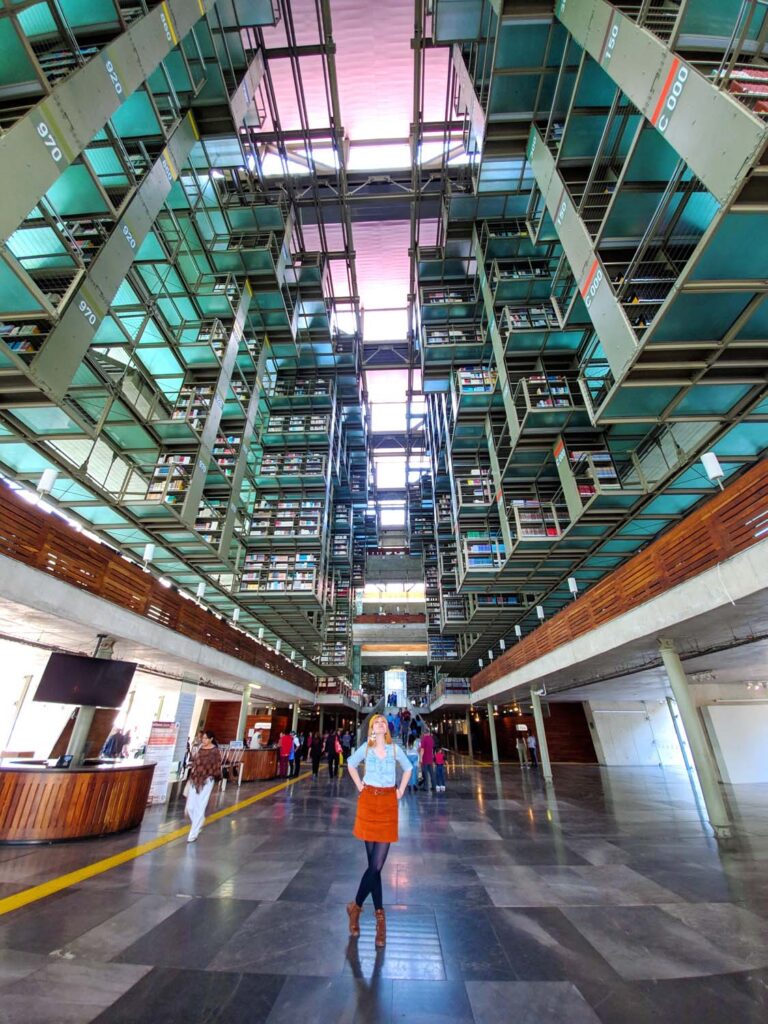
History
The word Ribera means “riverbank” in Spanish. After the European conquest of the Aztec city of Tenochtitlan, the colonizers drained the life-giving lakes around the Aztec temple. They did this in order to make room for the city’s expansion. But they quickly ran out of space and needed to expand outwards. The shallow Lake Texcoco was once located here in what is now the Colonia Santa María la Ribera. In 1545, this lake was also drained to claim more land. The land wasn’t originally considered a part of the greater Mexico City. It was handed over to the Catholic church missionaries where they could build their monasteries.
Rancho de Santa María
Hundreds of years later things began to change in Mexico City. Benito Juárez, the first indigenous president of Mexico, and a preeminent symbol ofMexican nationalism. Taking power in 1858, his government forced the Catholic landowners out of the country. Instead, the countryside was given back to the people and cattle ranchers moved in. The area which is now Colonia Santa María la Ribera, was owned by the Flores brothers. Their farm was named ‘Rancho de Santa María‘ which is where we get the name of the neighbourhood.
In 1859, the ranches were split up as the city just kept expanding. Santa María la Ribera became the first official subdivision of Mexico City. Residential homes were built as luxury getaways for the wealthy upper-class. These affluent families were looking to escape the busy city centre. They built country homes with large, spacious gardens. It was like being in the countryside despite being so close to the city.
In the early 20th century, the middle-class sought new residential neighbourhoods. And instead of building holiday homes, people were moving into the neighbourhood as their permanent residence. With this influx came the building of schools, parks and marketplaces. In order to serve the people who came to make this place their home.
1950’s Decline
But like Roma Norte, the post-war 1950s brought a drastic change to the neighbourhood. The land around Colonia Santa María la Ribera was sold off. An industrial zone with the trains coming in and out popped up beside it. Less than desirable in terms of noise. Lower rental prices drew in poorer residents. The upper class, put off by these newcomers, fled south to neighbourhoods like Polanco. Their old mansions were converted into apartments and businesses.
After the earthquake of 1985, a huge influx of people came to live in the neighbourhood. Unlike boroughs like La Roma, the damage to this area was pretty minimal. The government saw the preservation of this area as an opportunity. They began to move the displaced people of the inner city out to the northern districts. Despite the growth of economical housing, the area began to deteriorate. And in the 90s, the Colonia Santa María la Ribera was thought of as nothing more than a poor suburb. It was classed as a “barrio bravos,” where crime and drugs ran rampant.
21st Century Revival
But like the rest of Mexico City, things began to change in the 21st century. Tourists saw the preservation of many of these historic 19th-century buildings as a hidden gem. In fact, there are over 1,000 buildings here listed as historic homes. While it may have been true that this neighbourhood was once dangerous, the last ten years have turned it around. People call it the “new Condesa” thanks to its neo-classical Porfiriato mansions and beautiful walkable streets. But without the huge influx of tourists… At least not yet.
Location
The neighbourhood is located between Avenue Ricardo Flores Magon and Ribera de San Cosme to the north and south. And between the Insurgentes Norte and Circuito Interior to the east and west. It is easily accessible by Uber or taxi. If you prefer to take the metro you can reach the area via the San Cosme or Buenavista station.
Map of Walking Tour
Pasteleria El Globo
To start our walking tour, we need to grab something to eat. Sitting in the park with a cup of coffee and pastry is the perfect start to the day. Pasteleria El Globo, is located across the street from the main plaza, along Manuel Carpio street. El Globo is a historic bakery chain here in Mexico City. And while some bloggers might snub their nose up a visiting a “chain,” I think that’s just hogwash.
El Globo first opened its doors in 1884 in Mexico City. The word El Globo means “the balloon” as it was named after the invention of the hot air balloon. Don Benito León Acosta was a great Mexican inventor. His creation was one of the most important technological developments of the 19th century. The bakery managed to survive the political and economic upheaval of the Mexican Revolution, the great earthquake and more. El Globo persisted, and today they have over 170 different branches in 24 cities in Mexico. Grab yourself a small tray and fill up with whatever pan dulce (sweetbreads) look delicious to you. Pair that with a coffee, and you’ll be ready to have yourself a relaxing breakfast picnic in the park.
Alameda de Santa María
Alameda de Santa María was one of the first construction projects made to impress the new residents in the 19th century. These residents required a public space to match their high-class mansions. So the park was designed to stand out against other public spaces of the time.
While you might assume Alameda just means “park” it has such a deeper meaning than that. An alameda is a public walkway or promenade shaded with trees. In the springtime, the jacaranda trees explode in vibrant purple blooms that set the park alight. The park is designed to highlight the impressive central kiosk. Four octagonal tiled fountains in either corner of the park cast the gentle murmur of flowing water throughout the space. The perfect place to sit on a hot day to feel like you’re cooling down.
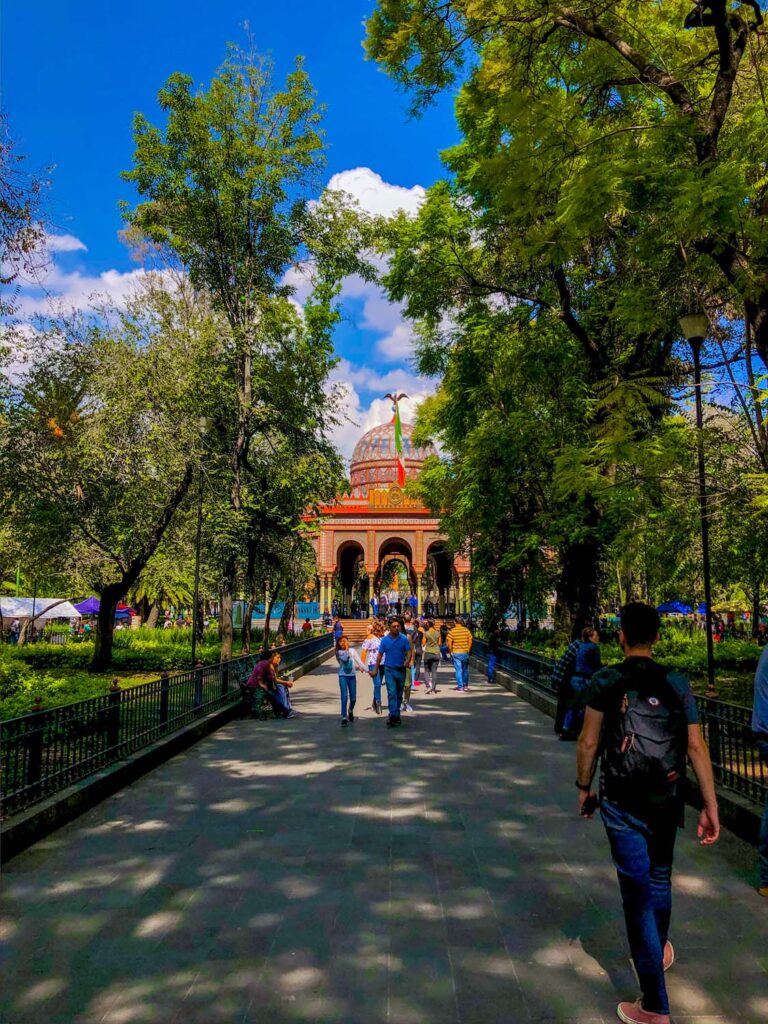
Kiosco Morisco
The highlight of the park is doubtlessly the Kiosco Morisco or Moorish Kiosk. It was, in fact, the main reason I was drawn out to this area of town in the first place! Despite the overall Islamic appearance, the colourful pavilion was designed by Mexcian architect José Ramón Ibarrola. The Kiosk was made for the 1884 World’s Fair in New Orleans. It was such a success that it was moved in its entirety to Saint Louis for the Exposition of 1902.
After touring the states, the structure was returned to Mexico. After some deliberation, they decided upon the new Colonia Santa María la Ribera park for its permanent location. Like the rest of the neighbourhood, the kiosk found itself in disrepair in the late 20th century. Many of the parts had been dismantled and used to decorate private homes. But thanks to the neighbourhood revival in 2003, the city restored the kiosk to its original glory. And glorious it is!
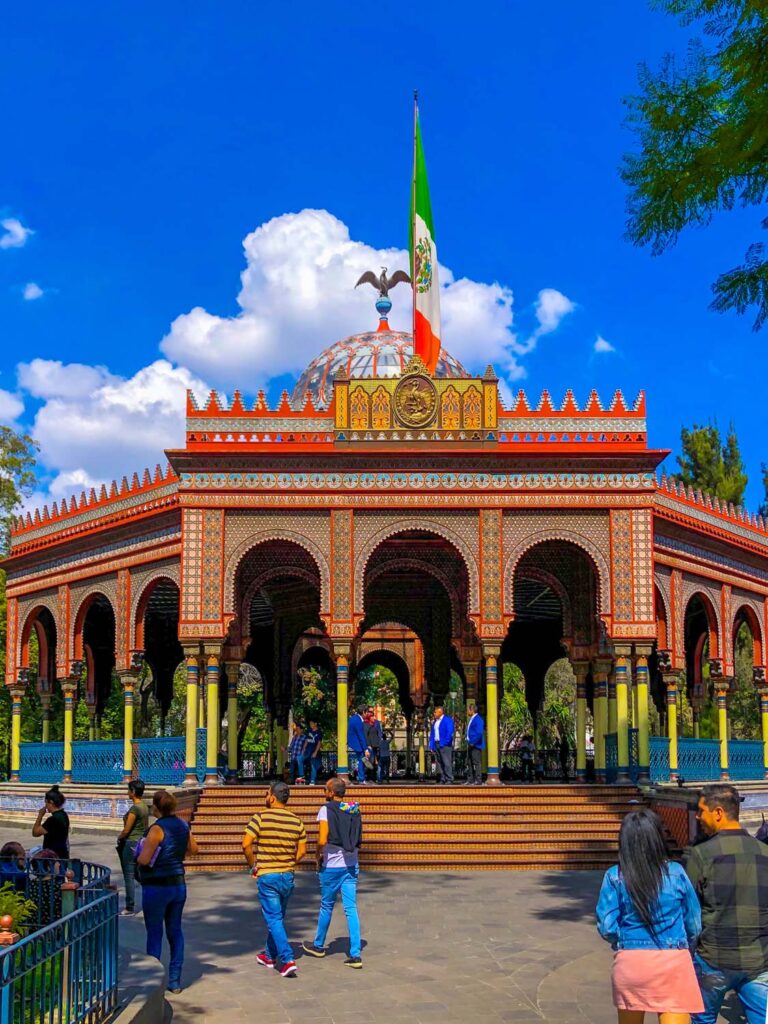
Design of the Kiosk
Despite the organic, wooden appearance, the entire structure is made of cast iron. Cast iron was a revolutionary material in the early 20th century. Also seen in the Museo Universitario del Chopo that we will see later in the tour. Cast iron allowed for the structure to be easily disassembled and reassembled time after time.
Mudéjar
The style of the ornamentations covering the whole structure is called Mudéjar. Mudéjar is a blend of Spanish and Moorish architecture and decorative elements. Mudéjar design is notable for its horseshoe arches, decorated in ornate mouldings. Geometric motifs combined with vegetal forms are another key design element. The structure is painted in deep red, pale blue and golden yellow. Primary colours that make such a visual impact.
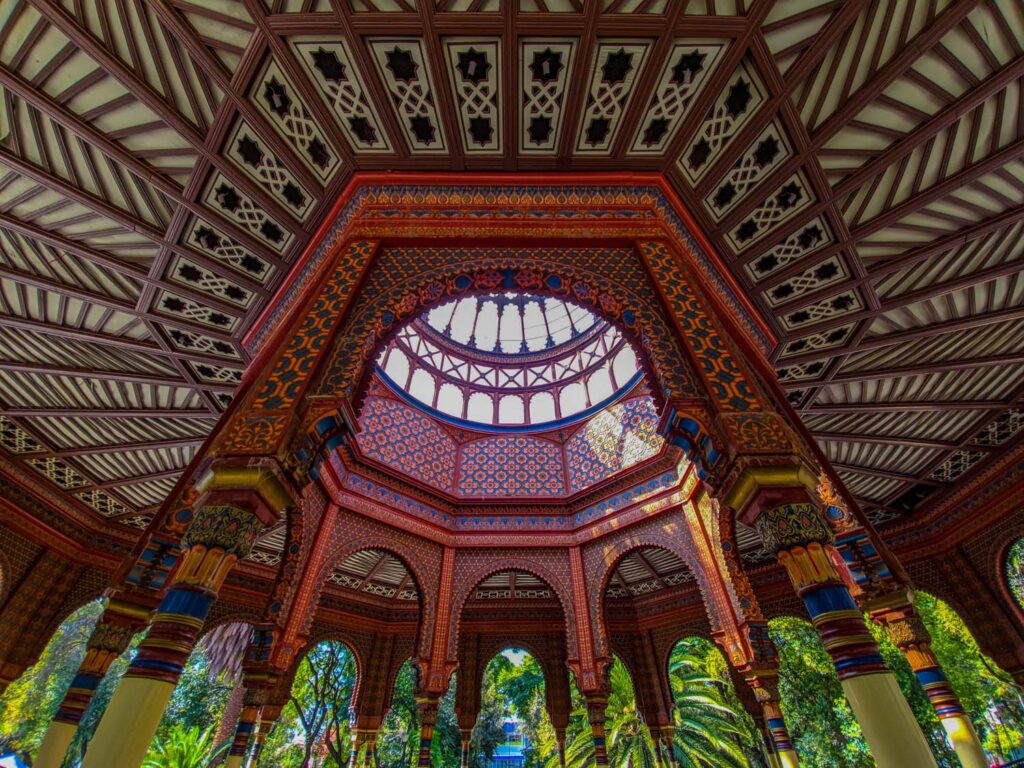
This style was made famous inside the Alhambra Palace in Granada, Spain. Locals often refer to the kiosk as the “Mexican Alhambra Palace” as there are so many similarities.
The top of the exterior is framed in a staggered parapet covered in the same intricate Islamic geometric designs. Both the front of the parapet and the steeple of the dome feature the image of the Mexico City golden eagle. The symbol the Aztec’s searched for as the place where they would build their great city. The place where Mexico City now rests.
The building features 44 bright yellow external pillars and eight internal pillars. The internal pillars support the central stained-glass dome. The elaborate glass cupola features rows of arched windows and Islamic inspired geometric shapes and patterns. The rays of light cast down into the centre of the kiosk a mirroring the shapes from above.

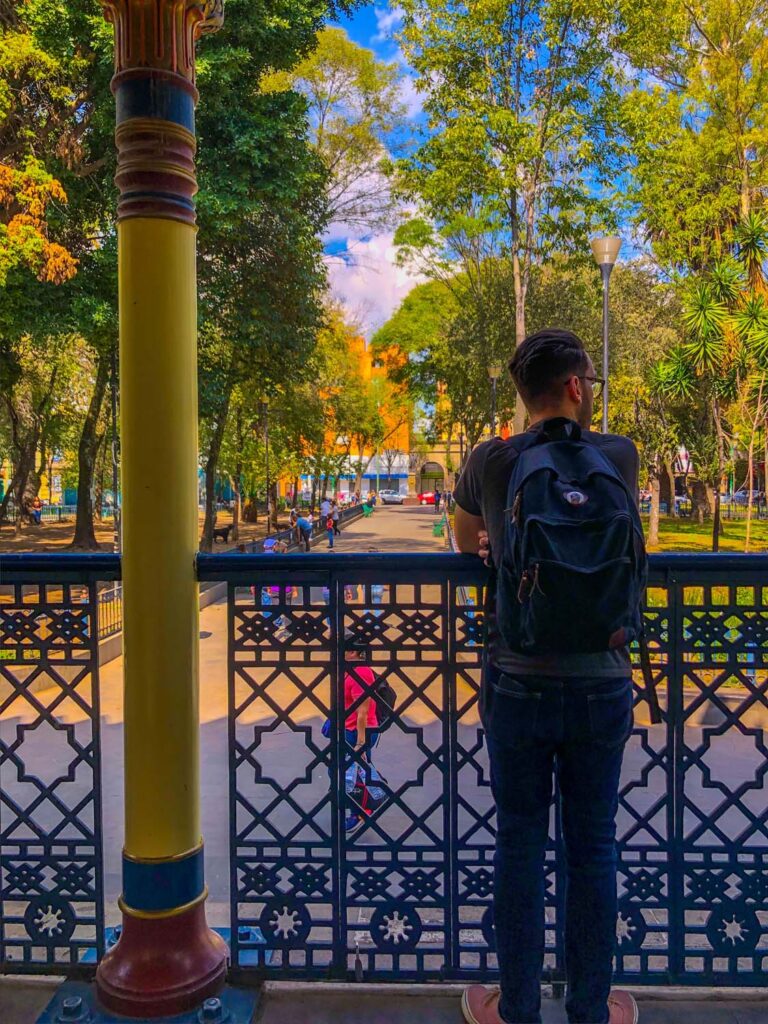
Dancing in the Plaza
The area around the kiosk is frequented by dancers, most commonly seen on Sunday afternoons. They will be seen dancing to cumbia music. Cumbia is a musical rhythm and traditional folk dance from Colombia but popular here in Mexico City.

Oaxacaquí
If you’re looking for a spot to sit and relax while taking in the sights of the park, head across to Oaxacaquí. The menu features an incredible array of traditional Mexican favourites. The interior is humble and yet brightly coloured with fantastical Mexican textiles. One of the house specialties of this place is the Tlayuda. A Tlayuda is a dish from Oaxaca made from a thin, crunchy, partially fried tortilla. The tortilla is then covered with refried beans, lettuce or cabbage, avocado, meat, and salsa. But best of all, it is topped with the all-important Oaxaca cheese!
Kolobok
Opposite the park is perhaps something you might be surprised to find in the middle of Mexico City. And that is a traditional Russian restaurant! Kolobok is one of the city’s only Russian restaurants and definitely the most popular. Ex-pats flock here on the weekend to get their fill of borscht, pierogies, goulash, and a myriad of Russian salads. Mayonnaise and beets flow like water here. You can also get classic Russian beer, imported all the way from the other side of the world. It’s definitely an oddity but has become a landmark in the neighbourhood. Kolobok is a wonderful example of how diverse Mexico City really is.
Tlacoyotitlán
But my favourite spot to eat while I’m in Colonia Santa María la Ribera is Tlacoyotitlán. Perhaps a bit on the touristy side, but I adore the lengths the owners have gone to present pre-Hispanic cooking. Tlacoyotitlán means “the land between tlacoyos (tortillas)” and represents the restaurant’s passion for creating the perfect tlacoyo (tortilla). Their tortillas are made with chalqueño corn from Texcoco de Mora. In this city, there are some farms that still grow this type of heirlooon corn.
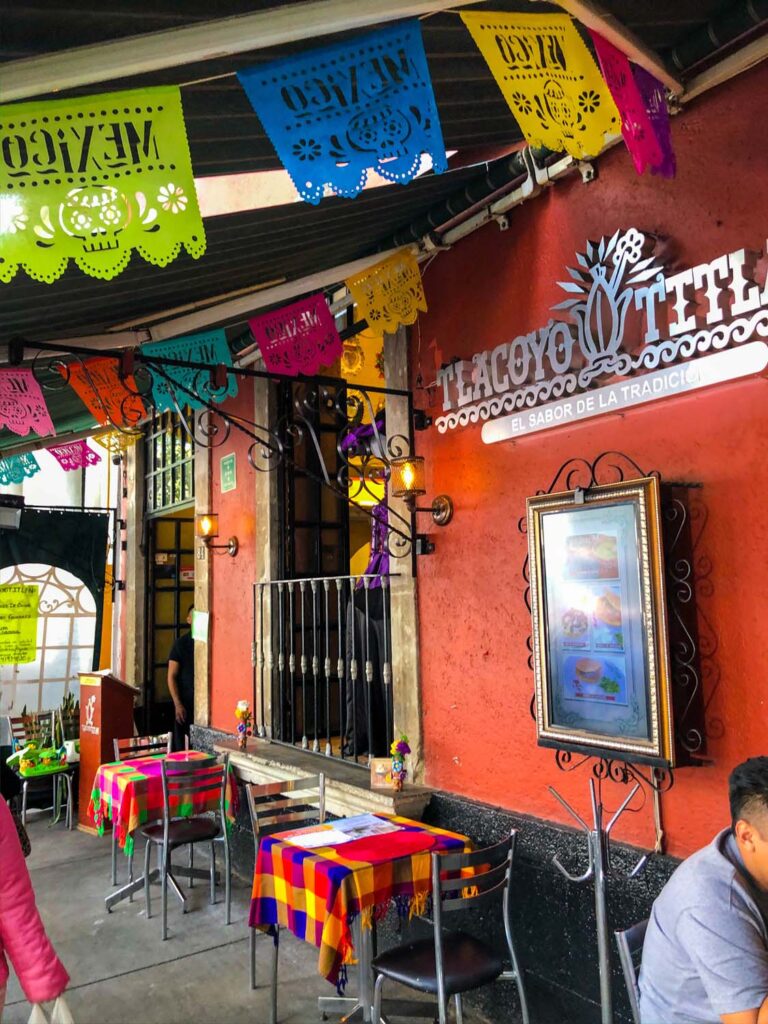
But what this restaurant is really famous for are their dishes made with, of all thing, bugs. Insects are actually super healthy and have recently began to be featured on menus in North America. But before it was trendy in Los Angeles, the ancient Aztecs knew all about their health benefits. Tlacoyotitlán uses pre-Hispanic ingredients such as escamoles (ants), grasshoppers and even moth larvae. Using these ingredients they have created fusion recipes that combine ancient traditions and street food staples. It’s absolutely worth a try if you’re here, as you’ll never get such an elevated form of the dish.
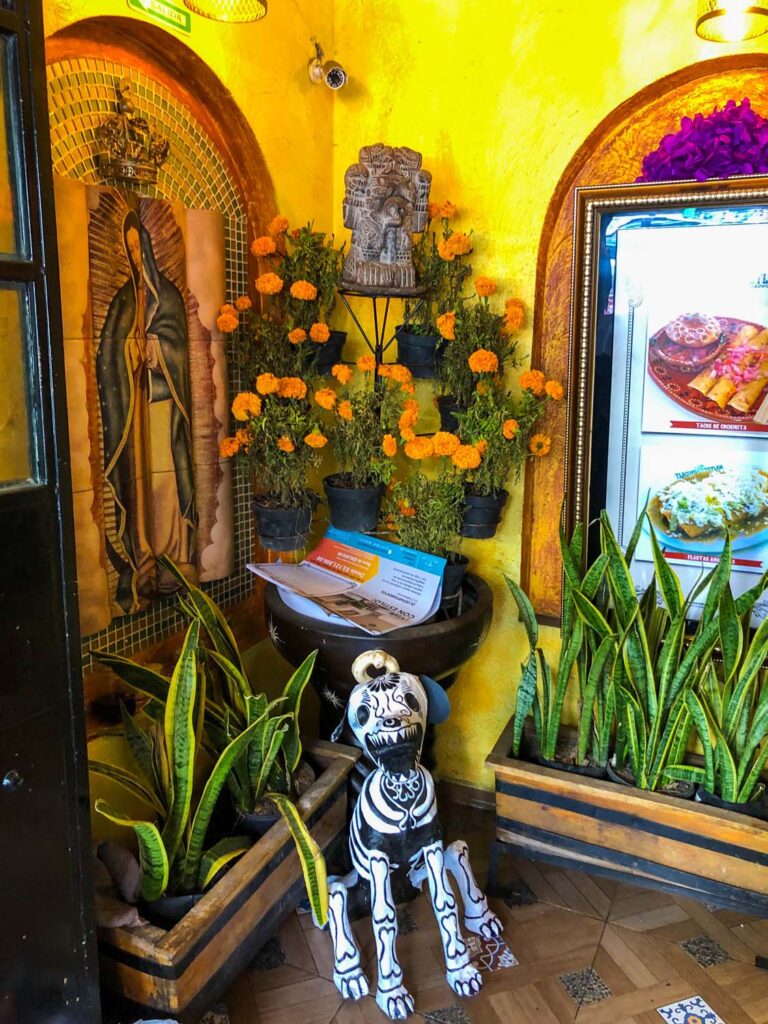
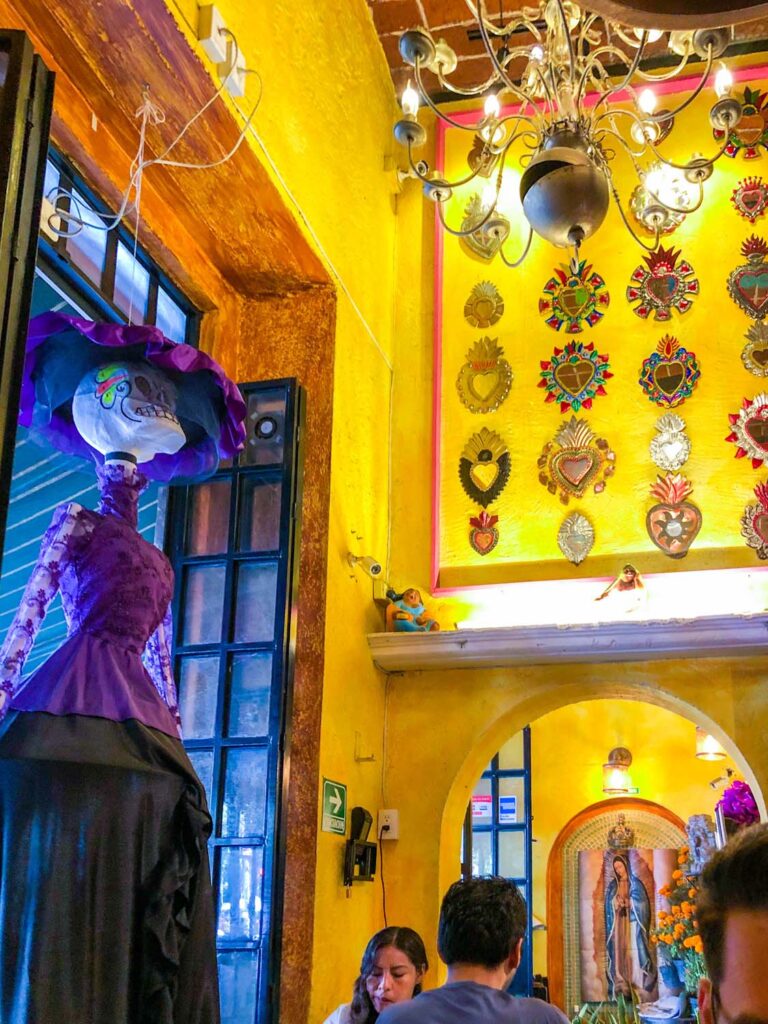
Corner of Jaime Torres Bodet and Calle Salvador Díaz Mirón
Before leaving this area, definitely make a stop at the intersection of Jaime Torres Bodet and Calle Salvador Díaz Mirón. The buildings on either three corners opposite the park are so representative of the architecture of the Colonia Santa María la Ribera. To the southeast we can see the building that houses a small Estética hair salon on the ground floor. This is one of the most unique buildings in the neighbourhood, featuring some incredible tile designs. On the second floor, the tiles almost appear to be weaving in and out of each other. The green and white tiles are angled back and forth on the other levels to create this mesmerizing effect. It almost looks as if this building was woven out of the tiles themselves.
On the southwest corner we have an old pharmacy. But housing the simple pharmacy is one of the most stunning stone-carved neo-colonial structures. With richly carved balustrades, ornate columns and bright green wrough-iron Juliet balconies.
Museo del Instituto de Geología
Turning north, we make our way towards the hulking stone building at the end of the street. This is the great Museo del Instituto de Geología. This behemoth of a building is one of the best examples of Porfirato Art Nouveau architecture in Mexico City. President Porfirio Díaz was obsessed with the Beaux-Arts architecture of Paris. He spent much of his time in government commissioning many buildings in Mexico City to be built in this style. Construction began in 1890 as a part of Diaz’s mission to bring Mexico City into the modern age. Not just architecturally but also with additional cultural developments like museums.
The Facade
Construction was completed in 1906 and opened as a foundation that aimed to promote earth sciences. The material used to build the exterior was stone quarried from the volanic rock of the valley of Mexica. In itself a literal slide of the bedrock of Mexico. The facade is intricately carved with images and relief inspired by Mexican scenery. There are also reliefs of shells, reptiles, fossils and even a few minature dinosaurs.
Interior and Collection
Stepping inside the door, you enter the domed hallway, complete with the incredible wrought iron spiral staircase. Today, the collection is rather outdated, but many people still flock here, just to view the art nouveau staircase. The swirling iron handrails with vegetal designs and fantastically detailed banisters make you feel like you’ve entered a regal Parisian manor.
On the second floor, just up the stairs, are a series of stained glass windows made by German artist, Franz Xaver Zettler. Each one features a different scene relating to mining and natural resources.
The most impressive part of the collection is their larger than life, mammoth skeleton standing in the great hall. Surrounding it, in antique glass cabinets are collections of fossils, vertebrates and invertebrates, minerals, rocks and meteorites. The first dinosaur bones found and restored in Mexico were exhibited here and can still be seen today.
Hours: Tuesday to Sunday from 10 a.m. to 5 p.m.
Admission: General admission $25 (pesos) Students, teachers and seniors $20 (pesos)
Mercado La Dalia
Head east along Manuel Carpio until you reach C. del Fresno. Turn north and walk a short ways until you find the Mercado La Dalia. The Mercado La Dalia or Santa Maria Market is oldest remaining neighbourhood markets in Colonia Santa María la Ribera. Families have been shopping for generations and the market feels wonderfully lived in. Since the market isn’t as busy or as large as the ones downtown, I feel like you can have a much more relaxed experience here.
Remember to ask before taking any pictures. I always think it’s polite to buy at least one thing when visiting these markets. A way to give back in exchange for a cultural experience. Grab a small handle of fruit or even just a bottle of water from one of the lovely vendors here. Named after the Dahlia, this market has an incredible selection of flowers. And today there are much more than just dahlias. If you don’t mind carrying a bouquet around with you this is a great place to grab one.
Tortillería y Molino La Dalia
Just across from the market, you can find the bright green exterior of the Tortillería y Molino La Dalia. This is where locals from the neighbourhood come every day to get their freshly made tortillas. Stacks and corn tortillas pour out of the machines operated by hand in the back. The neighbourhood Tortillería is a staple of the community and if you’ve never seen one in operation, definitely stop by! And while you’re at it, buy a stack of tortillas for yourself. There is nothing as good as a fresh tortilla! Rolled up and dipped in fresh salsa, is the perfect way to eat it.

Restaurante La Oveja Negra
If you are looking for something more substantial, head a few streets over to Restaurante La Oveja Negra. The Restaurante La Oveja Negra or the “Black Sheep Restaurant” is famous for their tacos de barbacoa. Barbacoa translates into Barbeque as the meat is made from a long and slow braising method. These tacos are usually made of sheep as this is the most traditional meat for Barbacoa (hence the restaurant’s name.)
The method of preparing barbacoa dates all the way back to pre-Columbian times. They begin by digging a hole in the ground and covering it with heated stones. The stones heat the hole for an entire day before the core temperate is hot enough to cook the meat.
After this, the prepared sheep is wrapped in maguey leaves. The leaves give the meat insulation from the hot stones and flavour the meat while it cooks. The oven is then covered in the same leaves and a layer of earth. A fire is lit on top, and the meat is left to cook for around 12 hours or more. The result is incredible! All the while enjoying this incredible meal, you are sitting inside this airy, courtyard-like interior. Covered floor to ceiling in brightly coloured Talavera tiles and papel picado (pecked paper). It feels like a celebration everyday in here.
Pulquería the Xochitl
Head north from the restaurant and continue east along with C. Eligio Ancona. Although this street is a bit run down, there are some truly spectacular examples of fine architecture along this road. Looks beyond the crumbling bricks, and you can find some real gems. Also found hidden along the street, inside a building that doesn’t even have a sign, is the Pulquería the Xochitl. Two saloon-style doors are all that let you know this place exists. Inside you’ll find a friendly atmosphere created from the drinks being served.
Pulque is a classical Nahuatl alcoholic beverage made from the fermented sap of the maguey (agave) plant. It is definitely an acquired taste and texture, to be sure. But if you’ve never tried it before, you should at least give it a go once! This Pulquería served up over 10 different Pulque flavours, which help overpower the slightly sour taste of the traditional variety.
Santa María La Ribera Street
From here, take a 12-minute walk back through the park and along Santa María La Ribera street. Walking along this street, you can appreciate how incredibly bright these neighbourhoods are. Every other house and apartment complex seems to be painted in yellows, reds, pinks and blues. Bringing such life to even the most simple exteriors. Along the way make a quick stop beside Alebrije café at #82 Santa María La Ribera. This incredibly dilapidated house still clings to the beauty of its art deco exterior. The vibrant colours of the stained glass balcony still stand out to all those who pass by.
Santa María La Ribera street is actually one of the more peaceful streets in the area, representing the neighbourhood. Unliked the boundary roads where are six lanes of traffic deep, here you’ll be able to walk without hearing much noise at all. People are out walking their dogs or taking their kids to school. Local street vendors and craftspeople are out on the street selling their wares, not for the tourists but for the area’s people.
Parroquia de la Sagrada Familia
Just past C. Sor Juana Ines de la Cruz we approach the magnificent Parroquia Josefina Sagrada Familia. While Mexico City is filled with incredible churches, this one stands out for being one of the most unique. The entirety of the church is designed in a Byzantine revival style. The eclectic style of neo-byzantine architecture seems to blend seamlessly into the landscape of Mexico City.
The church was built in 1899 when the popularity of this style was in its heyday. This style features domed roofs, broad arches and alternating coloured marble columns. Featured on this exterior are also these Islamic-inspired floral cutouts inlaid into the stone exterior. Sadly, you can’t appreciate the most impressive part of the building from street level. On the top of the building, you can see the incredibly bright green tiles covering the entirety of the onion domes.
Museo Universitario del Chopo
Head south on Santa María La Ribera toward Calle Ramón López Velarde. Shortly down Calle, Dr. Enrique Gonzalez is the towering Museo Universitario del Chopo. The great steel structure looms over you as you walk down the primarily residential street. It definitely stands out! Nicknamed the “Mexican Crystal Palace,” the building is designed in the art nouveau style of the time. Despite standing here today, the entire structure was originally built in Germany.
It was designed by Bruno Möhring in 1902 to house the Exhibition of Art and Textile in Düsseldorf. Wealthy Mexican businessman José Landero y Coss fell in love with the structure. Its remarkable glasswork and enchanted twin-style iron towers became the apple of his eye. When he heard it was being dismantled, he bought the entire installation. He then had to find a way to have it shipped, piece by piece, over to Mexico City. It took years to reassemble in the Colonia Santa María la Ribera. This neighbourhood was selected as both the building and the Colonia were symbols of modernity in Mexico City.
Mexican Crystal Palace
The building was reopened in 1905. In 1910, President Díaz used it to house the Japanese Pavilion to impress the visiting Japanese ambassador. In 1913 it housed the new National Museum of Natural History dedicated to natural sciences. Most of this collection can still be seen today at the Museo Nacional de las Culturas.
But in 1964, it was forced to close its doors. It was left abandoned in a neighbourhood that was also falling to pieces. For a minute, there was a good chance this architectural wonder would be dissolved for scraps.
Thankfully, in 1975, the Universidad Nacional Autónoma de México (UNAM) purchased the property and went about restoring it. After a few years, it was finally reopened as a cultural center rather than a permanent exhibition venue. Preserving this fantastic piece of architectural history. It was renamed the Museo Universitario del Chopo. Today, the building exhibits modern art projects for marginalized groups and young emerging artists.
Biblioteca Vasconcelos
From here, hop in an Uber and head over to the Biblioteca Vasconcelos to end the day. Although it’s definitely walkable, the streets are pretty chaotic over here. So taking an Uber right to the library’s front door is the most street-free way of making it out there. And when you’re done exploring the library, simply grab an uber to head back to your accommodation. The shape of the building almost resembles the haul of a boat or pyramid. The edges leaning in towards each other. Architect Alberto Kalach designed the library as an “ark, a carrier of human knowledge, immersed in a lush botanic garden“.
The project itself was a pretty controversial one. It was projected to cost 100 million pesos and yet ended up costing over 250 million pesos! That is in addition to the 13 million pesos annual budget. Many people balked at this monumental library being located in the northern suburbs, perhaps in a less affluent area. But Kalach really wanted to bring this temple of knowledge to everyone.
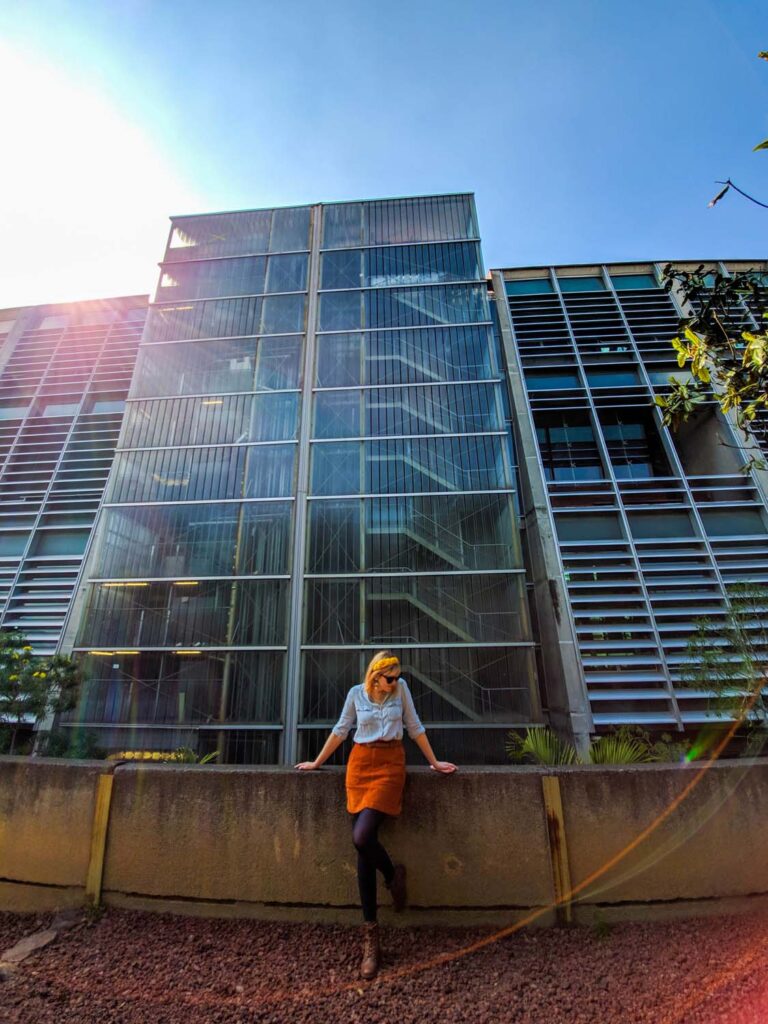
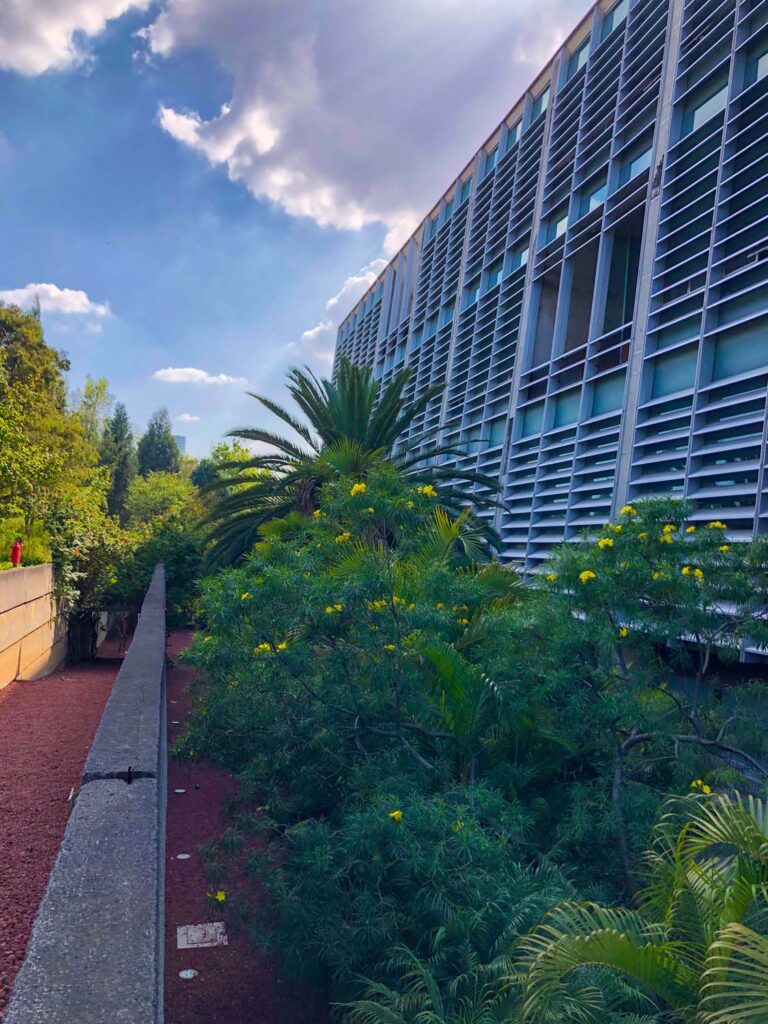
Surrealist Library Interior
Walking into the library, you are immediately overcome with the spectacle of this place. Towering over your head are hundreds of seemingly floating metal bookshelves suspended from the ceiling. The surreal look it gives to the visitors upon walking inside is unmatched.
The bookshelves are located along with these floating platforms six storeys high. Shelved withing metal frames with smoked-glass inserts that cast the most ethereal teal glow throughout the space. The shelves are positioned along these heavy-duty tracks hanging from the ceiling. This allows the shelves to be moved around as required since library collections are always expanding.

Great Baleen Whale Sculpture
On the ground floor, suspended between the racks of books, is a hulking skeleton of a great Baleen whale. While it might look real, it is indeed a sculpture by artist Gabriel Orozco. Since Kalach designed the library to look like an arc, it feels fitting to have this whale incorporated into the building. Whales are a biblical reference seen in stories featuring biblical characters like Noah or Jonah.
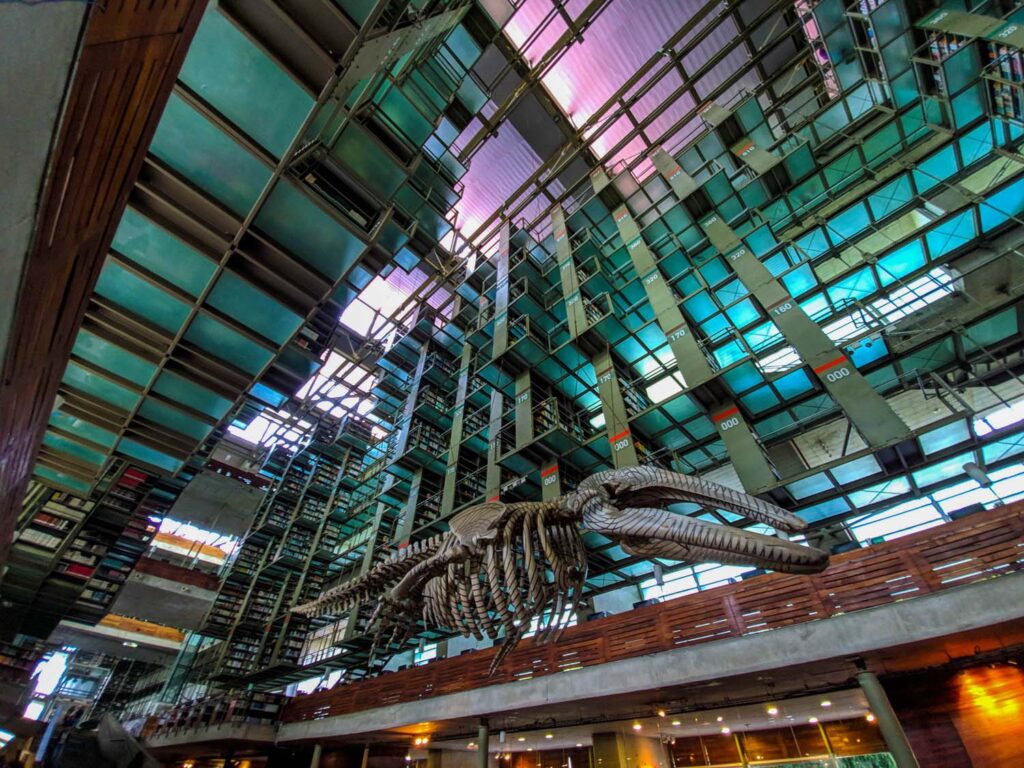
Light in the Library
Natural light was one of the most important aspects of the architectural design. Many libraries are dark, ancient feeling spaces that, while beautiful, maybe aren’t the most welcoming. But the Biblioteca Vasconcelos is a space where you almost feel like you’re sunbathing while reading. But if you look closely, you’ll see that the light never enters the building directly. The light is always either diffused or enters at an angle. This produces a less harsh illumination and protects the books from damage. Even the roof is made from this slightly opaque pink glass that allows light to pour into the space. It makes the space feel airy despite all the heavy metals. It truly does feel more like a cathedral than a library.
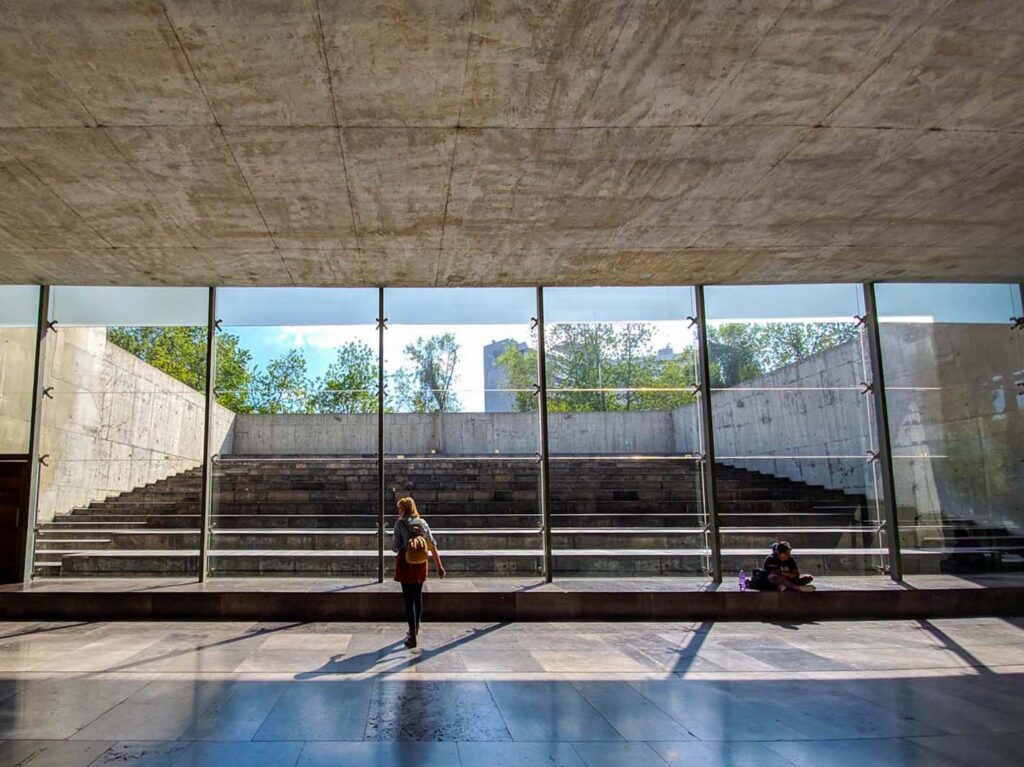
Book Collection
The books inside the library are available to the public. But the collection also features some rare books which once belonged to famous Mexican writers, artists and poets. There is even a braille room you can explore with books and exhibits for the blind.
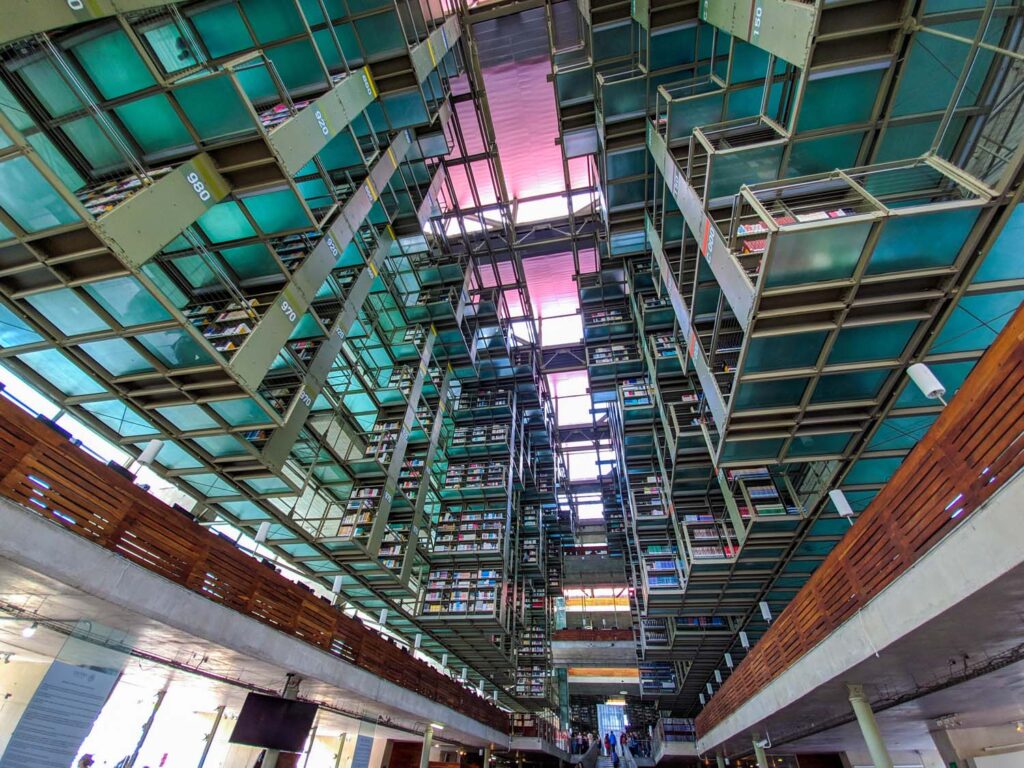
Botanical Garden
Outside the library, you’ll find a maze of lush botanical gardens to explore. The garden features a myriad of plant species representative of the Valley of Mexico. There are fruit trees, edible plants, aromatics, shrubs and hanging vegetation. All the plants make the garden feel like it has been here for ages like the hanging gardens of Babylon. I spent almost as much time outside exploring the gardens as I did walking through the library itself.
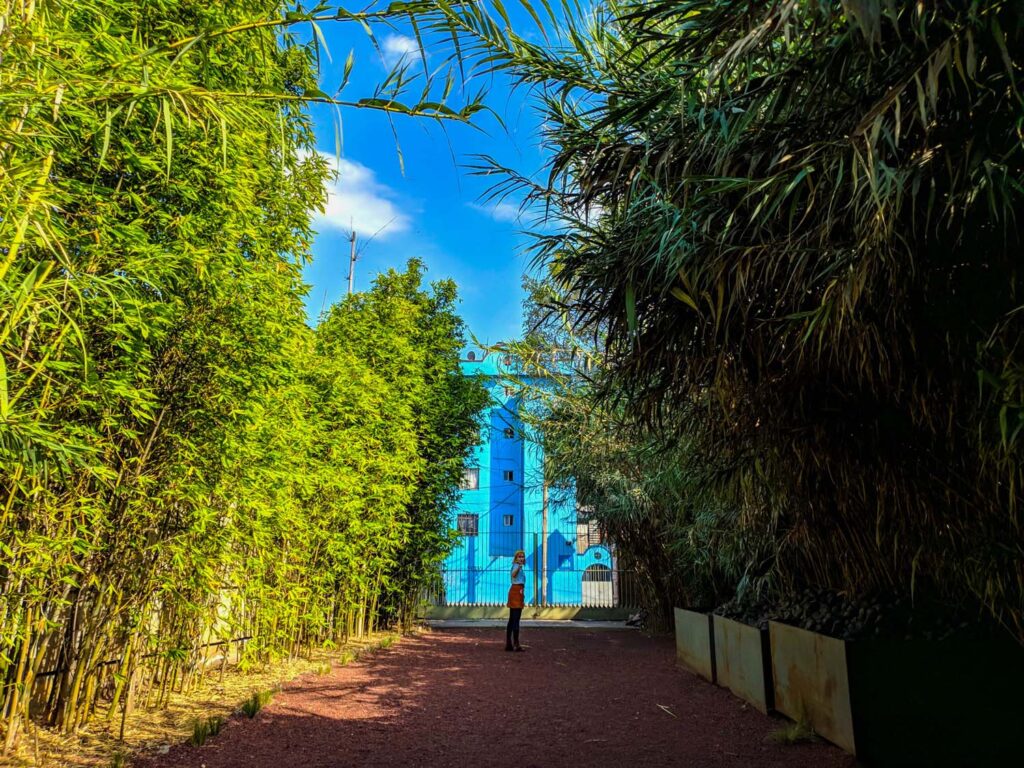

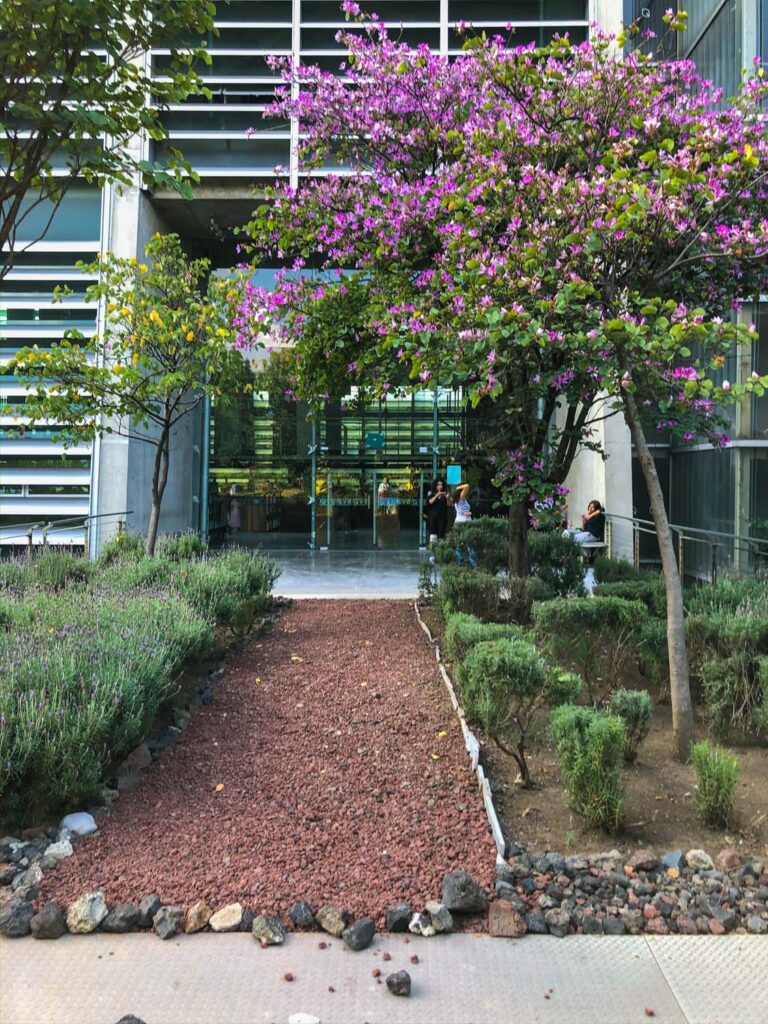
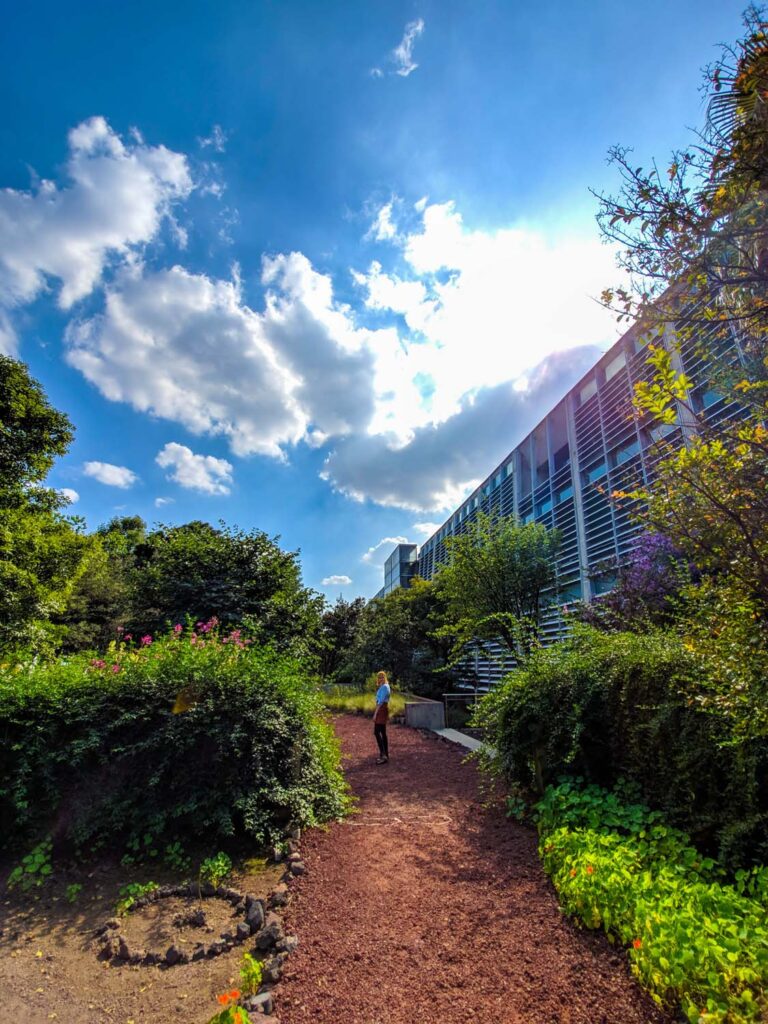
I hope you enjoyed this lovely walking tour of Colonia Santa María la Ribera. It is truly one of those hidden cultural and culinary gems of Mexico City! Let me know in the comments where we should explore next!
Happy Travels, Adventurers
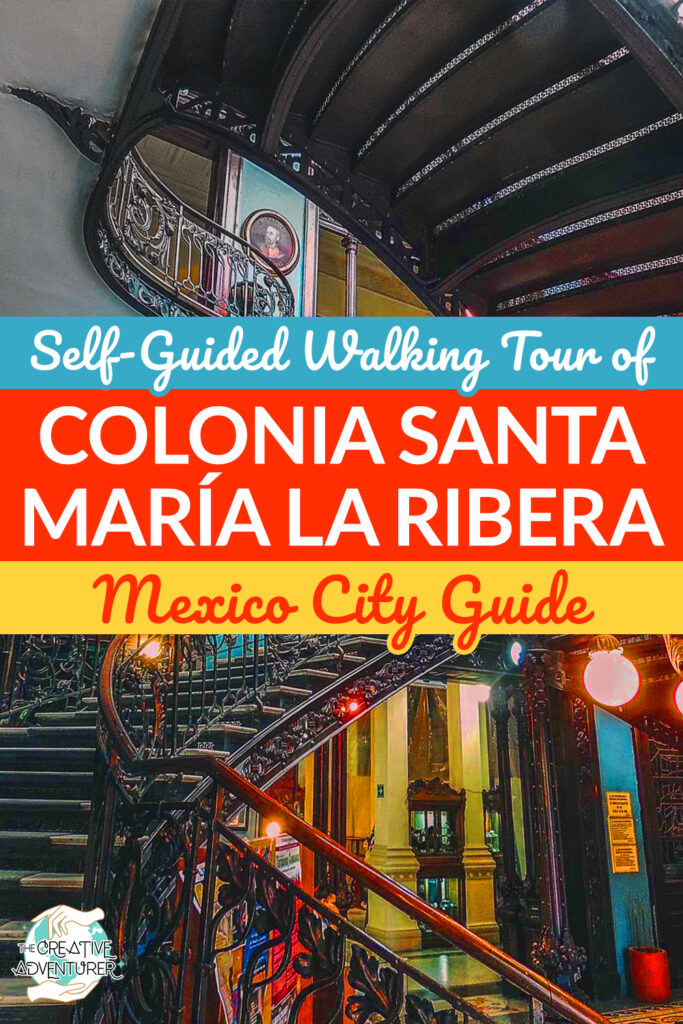
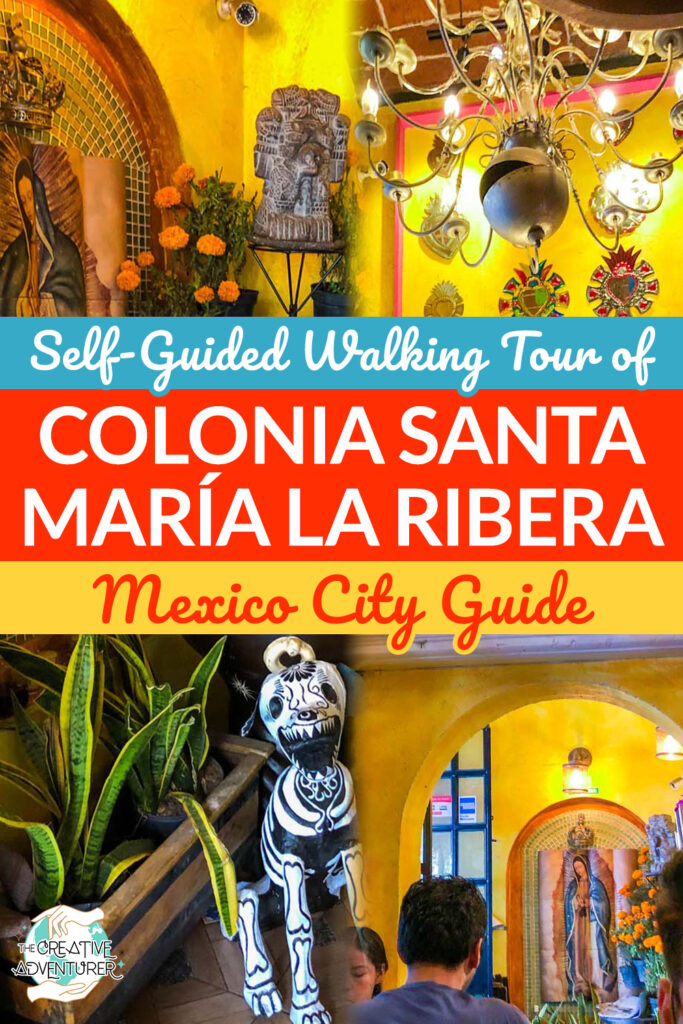




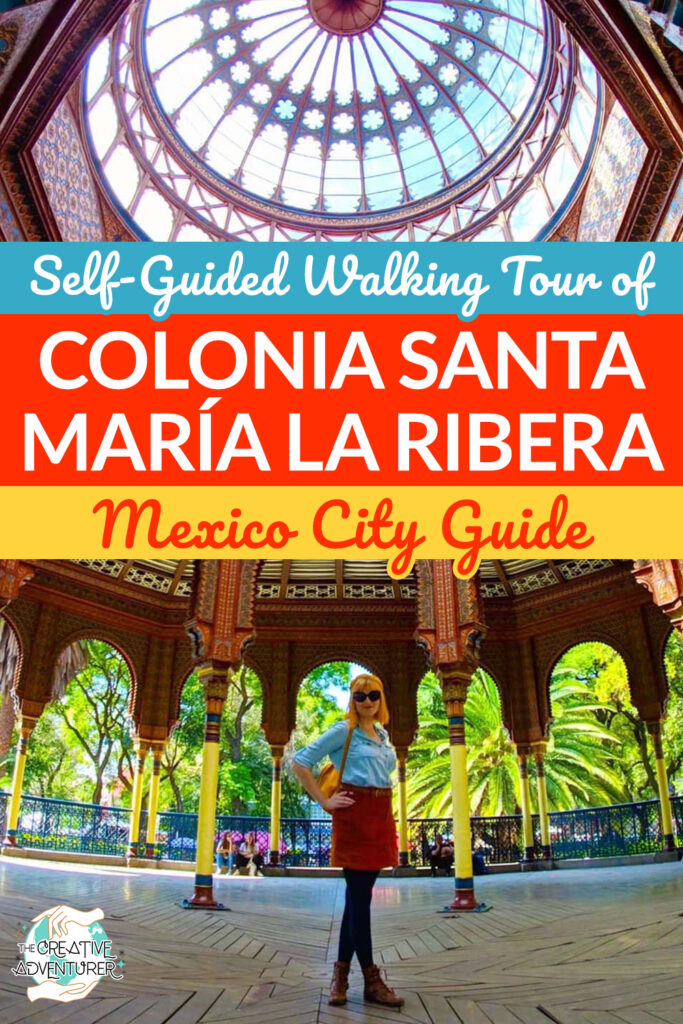



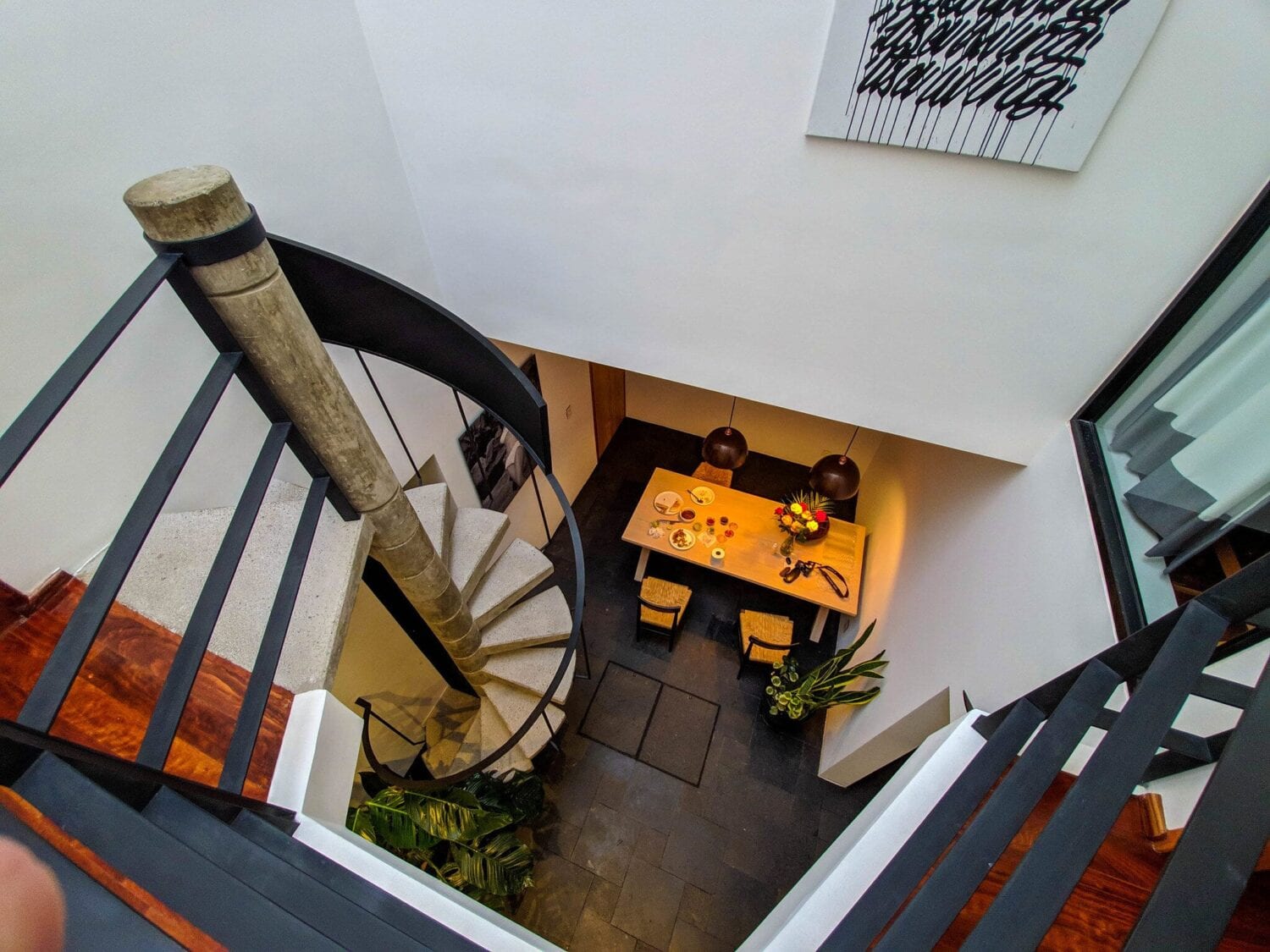

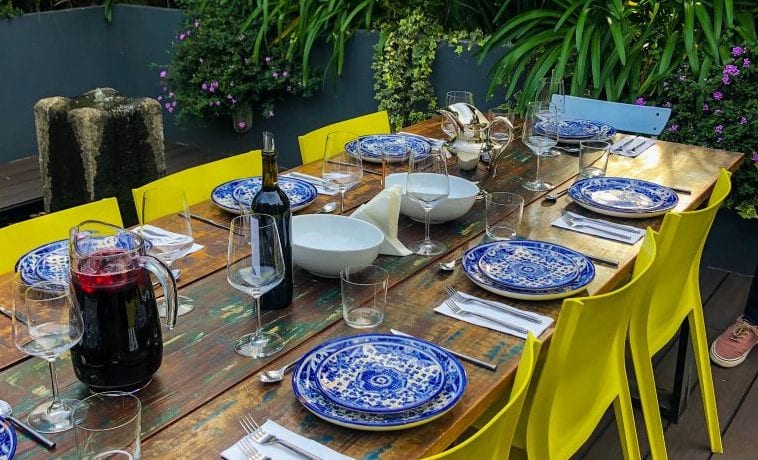
1 COMMENT
Tony Palazzolo
1 year agoOff to Santa Maria la Ribera on 22 Sept. Looking forward to using your guide and spending time among the bohemians there. Will reserve a table at Maria Cento38 to see what Mexican-Sicilian food is like!